Modelsvit 1/48 F-82G Twin Mustang
The Airplane:
The North American F-82 Twin Mustang is the last piston- engine fighter ordered into production by the United States Air Force. The airplane was based on the North American P-51H Mustang and was originally designed to meet a specification for a Very Long Rang escort fighter for the Boeing B-29 Superfortress. The war ended before the first production aircraft were operational.
Originally intended as a very long-range (VLR) escort fighter and designate P-82, the “Twin Mustang” was expected to escort Boeing B-29 Superfortress bombers on missions exceeding 2,000 miles from the Philippines to Tokyo; such missions being beyond the range of the Lockheed P-38 Lightning and P-51D Mustangs.
In response to a RFP from the USAAF, North American Aircraft began work in October 1943 on a fighter could fly over 2,000 miles without refueling. Edgar Schmued, the chief designer, adopted a twin-fuselage design similar to the Bf-109Z "Zwilling". While the P-82 was based on the lightweight experimental XP-51F, it was altogether a new design. Schmued started with two P-51H Mustang fuselages that were lengthened by a 57-inch fuselage plug located behind the cockpit, for additional fuel tanks and equipment. The center wing that joined the fuselages held the armament of six .50-caliber M3 Browning machine guns around the centerline, providing concentrated fire. The first XP-82 prototype was equipped with a removable centerline gun pod housing eight additional machine guns, and an even more powerful centerline gun pod containing a 40 mm cannon was considered, but was never built. The outer wings had hard points for carrying up to four 310-gallon drop tanks or 1,000 pounds of ordnance in the inner pylon. The vertical stabilizers incorporated large dorsal fillets for added stability in case of engine failure. Each main gear retracted into bays under each fuselage center section.
The XP-82 was powered by two Packard-built Rolls-Royce V-1650 Merlin engines. Initially, the left engine was a V-1650-23 with a gear to turn left propeller to turn opposite to the right propeller, which used a V-1650-25. In this configuration, both propellers turned upward at the centerline, but the first prototype refused to fly with this arrangement. A month of work resulted in the discovery that with the propellers rotating in ths manner, their upward rotation created sufficient drag to cancel all lift from the center wing section, one-fourth of the aircraft's total wing area. The engines and propellers were reversed, rotating downward over the center section, which solved the problem.
The first XP-82 prototype (44-83886) was completed on May 25, 1945, and made its first successful flight on June 26, 1945. It was accepted by the USAAF on August 30, 1945. Overall performance of the XP-82 was such that the production P-82Bs had been ordered in March 1945.
The XP-82 prototypes, and production P-82Bs and P-82Es, had both cockpits fully equipped so the airplane could be flown from either position on long flights, while later night fighter versions kept the cockpit on the left side only, placing the radar operator in the right position.
Some P-82B airframes were completed before the war's end, but most remained at the factory awaiting engines until 1946.
The XP-82 prototypes and the 20 P-82Bs using Packard- Merlins had a top speed of 487 mph. The USAAF had always wanted the P-82 to use an American engine; when the British increased the royalty for US-built Merlins, the powerplant was changed in August 1945 to the Allison V-1710-100 engine. Two P-82Bs were converted to one P-82C and one P-82D for development purposes. It was found the Allison-powered Twin Mustangs had a top speed of only 461 mph. The P-82D, now designated F-82E with the USAAF becoming the USAF, was ordered into production in 1947, following the Russian display of four Tu-4 reverse-engineered B-29s at the Tushino Air Disply. The P-82Bs were utilized as trainers, the only time the trainer version was faster than the operational fighter, other than the T-33 which was faster than the F-80.
Production of 100 F-82Es as long-range escorts for Strategic Air Command was completed in 1948. The 27th Fighter Wing was re-designated the 27th Fighter Escort Wing and began operations from SAC HQ in Nebraska. The unit moved to Bergstrom AFB in Texas in 1950, where they began converting on to the F-84E Thunderjet. Their F-82Es were sent to Ladd AFB Alaska, where they flew as escorts (to the border) for B-36s that penetrated Siberian air space in 1952-53.
The night fighter version was developed to replace the aging Northrop P-61C for use in Air Defense Command pending acquisition of jet-powered interceptors. These were divided into 100 F-82Fs using an AN/APG-28 radar, and 80 F-82Gs using a SCR-720C-18 radar. The F-82Fs equipped ADC squadrons based at Hamilton AFB outside San Francisco and McChord AFB outside Seattle, and McGuire AFB outside New York City, while 48 F-82Gs equipped the Far East Air Force, with the 4th F(AW)S at Naha AFB Okinawa, the 68th F(AW)S at Itazuke AFB, Japan and the 339th F(AW)S on southern Honshu and Johnson AFB in northern Honshu, Japan. The F-82Gs arrived in FEAF in February 1950.
When North Korea invaded South Korea on June 25, 1950, it was at first unclear whether this was in response to a provocation by the Republic of Korea (ROK), since there had been several incidents back and forth in preceding months. An F-82G from the 68th F(AW)S carrying four drop tanks, was able to fly to the 38th Parallel shortly after dawn and confirm that it was indeed the North Koreans who were the invaders, with several columns of T-34 tanks already well past the border.
The F-82 was the only Air Force fighter aircraft capable of flying to the region of Seoul from Japan. At first, the airplanes were used to fly cover later the next day, June 26, for the evacuation of American diplomatic personnel and their families to a ship at Inchon. At 1300 hours, two North Korean People's Air Force fighters - identified variously as La-7s, La-11s or Yak-9s - intercepted the F-82s over Inchon, but there was no combat.
With the evacuation successfully completed, on June 27 the F-82s flew cover for C-54s flying in military supplies to Kimpo Air Base outside Seoul. With only 32 F-82s operational in Japan and Okinawa, the 4th F(AW)S sent eight F-82s to Itazuke, while the 339th provided another seven. With the 12 the 68th had, there were a total of 27 F-82s available for operations over Korea, with the three squadrons combined as the 347th Fighter Group (All-Weather) Provisional with LCOL John F. Sharp assigned as commander.
Three four-plane flights of F-82s were over Kimpo shortly after dawn on June 27 as C-54s began flying in with supplies for the ROK forces. At 1150 hours, five NKPAF fighters - two Yak-9Us, two La-11 trainers with light bombs, and what was identified as an La-7 but was more likely an La-11, were spotted heading for Kimpo to attack the C-54 just preparing to take off. One of the Yak-11s scored several hits on the vertical stabilizer of the 68th squadron's 1st Lt. Charles Moran. Moments later, element leader 1st Lt. William G. "Skeeter" Hudson engaged the Yak-11; closing on its tail, he opened fire and got hits. The Yak banked hard right, with Hudson in close pursuit. A second burst set the right wing gas tank on fire, knocking off the right flap and aileron. The pilot bailed out, but the observer, either dead or badly wounded, remained in the aircraft. The North Korean pilot was immediately surrounded by South Korean soldiers, who he engaged with his pistol. The ROK soldiers returned fire and killed him.
Moments later, Lieutenant Moran shot down what he claimed as an La-7 over the airfield, while Major James W. Little, CO of the 339th, shot down another La-7 (It has since been determined these were both most likely the two Yak-9s). The C-54 was able to escape. Three NKPAF aircraft had been shot down, with pilot Lt. William G. "Skeeter" Hudson and radar operator Lt. Carl Fraiser scoring the first United States aerial "kill" of the Korean War.
On June 28, F-82s - including the 4th squadron's “Mid Night Sinner,” FQ-390 - escorted Douglas MacArthur's C-69 Constellation “Bataan” to Kimpo, where he was to meet ROK President Syngman Rhee. While MacArthur was on the ground, other NKPAF fighters attempted to attack the airfield and were chased off by the F-82s, which claimed two shot down.
Over the next desperate two month as UN forces retreated into the Pusan Perimeter, the F-82 was the only fighter that could escort B-26 Invaders to attack the enemy north of the battle zone.
On July 5, the 339th Squadron returned to Johnson AB; the squadron had been in combat a total of 10 days, flying a total of 44 combat sorties for which they had been given no training.
On July 10, F-82s from the 4th and 68th squadrons joined B-26s and F-80s to hit North Korean road traffic. An estimated 117 trucks, 38 tanks and seven personnel carriers were destroyed, along with a large number of enemy troops killed when the B-26s destroyed a bridge at Pyongtaek, causing a massive jam.
On July 11, the 4th Squadron returned to Okinawa and the 68th Squadron was left to carry on the battle. Throughout July and August 1950, F-82s attacked enemy trains, vehicles, and constantly strafed North Korean troops on the roads. On August 27, two F-82s were patrolling over South Korea over a thick overcast when they received an urgent request for air support from hard-pressed ground troops. Darkness was approaching when they found UN ground troops pinned down by a concentration of mortars. The F-82 pilots made several passes to get set up with the ground controller, and as soon as the enemy target was pinpointed, they attacked the enemy for 45 minutes. Following their last pass, the mortars were silent and ground forces later counted over 300 enemy dead.
By the fall, after the Inchon Invasion, the F-82s began operating from Kimpo and Suwon air bases, conducting night intruder missions over North Korea and providing close air support over the battlefield. The fighters were moved to Pyongyang following the Chinese intervention in November, to provide cover for “The Big Bug-out,” the escape of the UN forces from North Korea. After the fall of Pyongyang and then Seoul in December, the F-82s retreated to Japan, where they were again the only USAF aircraft capable of providing extended support to ground forces from Japanese bases.
The F-82s were only kept operational by turning some nto hangar queens for parts. When the F-82F and G were ordered, they were considered so temporary that no spare parts had been ordered for them! FEAF asked for reinforcements, but the Air Force would not release the ADC aircraft in the United States.
By the summer of 1951, the 68th's F-82s were replaced in the night air defense role by the F-94B Starfires of the 319th F(AW)S. Those not scrapped were transferred to Alaska to supplement the F-82Hs, along with the surviving F-82Gs from the 4th and 339th squadrons. The last F-82s left operational service in Alaska in June 1953. During their time in combat, 11 F-82s were lost to enemy ground fire.
The Kit:
The F-82 has interested modelers ever since Monogram brought out its 1/72 kit of the airplane back in 1972. Hobbycraft released a kit in 1/48 back in the 1990s that tops most modelers' list of “Difficult Kits.” The kit has probably ended up in the trash more often than it has resulted in a model.
Two years ago when Modelsvit released their P-51H Mustang to acclaim, they announced they would release a 1/48 F-82 Twin Mustang by the end of 2020. As with many other plans made that year, things took longer than planned. The company released 3D computer plans this past summer, and it was obvious they were going to equal the P-51H with this release. The kit was finally released on December 1 as an F-82F/G night fighter.
The kit marks Modelsvit's best yet, a “high-end limited-run” kit. While a modeler should still assemble the kit as if they were doing a limited-run kit, checking the clean up all sprue nubs and such, they will find that the parts assemble almost as well as an Eduard kit.
The kit provides two different canopy options, open or closed, and these canopies are much thinner and clearer than those that came with the P-51H. Unlike earlier Modelsvit kits, there is a minimum of photo-etch, this being limited to instrument panels, seat belts and the delicate exhaust baffles that probably can't be done any other way.
Decals are provided for four aircraft: two F-82Fs from stateside units and two F-82Gs from the 4th and 68th squadrons that saw service in the Korean War. All of the options have nose art or names and the decals appear to be opaque enough to maintain their color over a black model.
This is not a small model - it is some 150 percent larger than a standard P-51 so far as the fuselages are concerned, with a wingspan almost equal to an A-20 and greater than a Beaufighter.
Construction:
The instructions in the kit are comprehensive, and if a modeler commits the revolutionary act of following them, an excellent result is guaranteed.
Construction begins with the cockpits, which I painted Interior Green on the sprue, then painted the various details. The frame for the seat is very delicate - really too delicate. In the end, after everything broke off it from minor handling, I made seat frames from .015 diameter Evergreen plastic rod.
Once the cockpits were complete, I glued each into their respective outer fuselage halves (i.e., the part that has the full dorsal fin. I then painted and attached the radiators and their ramps, and the tail wheel well parts, and attached them. I lightly sanded down the vertical fin upper edge on the inner fuselage halves, to insure good close fit. Test-fitting showed everything would come together and fit. I ran Tamiya Extra Thin glue into the mating area of the dorsal fin on the outer fuselage half, then brought the fuselage halves together and glued them. If you take your time and do a few inches at a time, you can insure that the fuselage halves come together correctly along the centerline, which will mean you will only have to lightly scrape that joint once the glue has set up, for it to disappear. I rubber banded the fuselages and set them aside.
Another modeler has discovered that the lower wing park of his kit was slightly warped. Any warpage at all will wreck your chances of aligning the model, so check that part closely - he says it's difficult to spot - and if it is, get that straightened out before proceeding to assemble the wing.
I assembled the wheel well. It is a good idea for you to sand down the left forward corner of the left wheel well walls about 1/32 inch, which will guarantee the upper center wing part fits correctly. I glued the upper center section in place and then test-fitted each fuselage to insure everything would mate up right and was lucky when it did. I then attached each outer wing half in turn, test fitting the fuselages for each, to insure that the fit at the leading edge of the wing was right. When the wing set up, I fitted the fuselages in place and glued each. By taking care in doing this test-fitting, everything went together right, thus insuring that the model was aligned properly. I rubber banded the forward mating area of the lower wing and fuselage lower nose. I attached the horizontal stabilizer and once I was sure it was properly aligned, I rubber banded the rear fuselages to hold everything in position while the glue set up.
The ailerons, elevator and the flaps all have the over-under parts fit to give sharp trailing edges, and these do not need any thinning to get proper fit (but check anyway). You should attach the outer flaps first, then the ailerons, then attach the center section flap and insure it is aligned with the outer side flaps. The attachment for the elevator has you press the elevator onto a ridge in the horizontal stabilizer. This didn't want to fit, so is shaved it off and sanded the leading edge of the elevator so that when I glued it on it drooped a bit. Alternatively, you could leave the elevator unassembled, attach the upper part in position, then glue the lower part in position.
I decided to use the closed canopy option for the radar operator's canopy, and the open canopy option for the pilot. I found that the sliding canopy needs to have its lower edge scraped down to a knife edge, while the deck that fits inside the canopy should be sanded down to half its thickness, so that the open canopy will sit right on the fuselage. The canopies are all clear enough that you can use the closed canopy option for both and still see the cockpit detail. You should also scrape down the interior of the front edge of the windscreen to get it to fit flush with the fuselage, and you need to do some trimming of the cockpit edges cutting the raised area back about 1/32 inch, so that the windscreen will fit nice and tight.
The radome went together without problem and fit perfectly to its position on the wing.
WIP photos are in the Night Fighters Group pages.
Painting:
F-82G Twin Mustangs and Model-T Fords have this in common: you can have any color you want, so long as it's black.
I painted the model with Tamiya X-18 “Semi-gloss Black” thinned 40 percent and misted on to get a nice smooth finish. Because of the semi-gloss finish, I did not need to apply any clear coat before applying the decals.
Semi-Final Assembly:
Once the model was painted, I attached the landing gear. This is the one “funny” part of the build, as it is not apparent how the main gear leg fits in the well. I consulted the close-up photos I found on the internet of the landing gear and attached the main gear leg in its proper position using CA glue to hold it. I then attached the main wheels. I finished off by attaching the tail wheels, testing the “sit” to be sure both tail wheels touched the ground and modifying it as necessary to achieve that.
Decals:
The kit decals are excellent. They are properly sized and in the correct “North American font” (the same as used on the F-86). The decals want to go on, and settle in under a bit of Micro-Sol without any silvering.
I had purchased the Print Scale Decals sheet, which has Lieutenant Hudson's Yak-killer as an option. As with most Print Scale sheets, this is poorly researched. Nearly all the markings are 125-150% too big in comparison with the correct kit decals. The “buzz number” and serial for Hudson's airplane are the only decals on the sheet that are useable if accuracy is important to you. I'll do Hudson's airplane with the second kit when it arrives.
Final assembly:
I unmasked the canopies and placed the open canopy in proper position. Be sure when you attach the propellers that you put the proper one on each fuselage - the props counter-rotate toward each other, coming down over the center section of the wing.
It is physically impossible to mount all five rockets on the underwing rocket tree. I decided this would be a model of “Mid Night Sinner” on the MacArthur escort mission when there was a severe ordnance shortage and the airplane was only carrying six rockets. That's my story and I'm sticking to it. I finished assembly by gluing the drop tanks in position.
I airbrushed a line of grey exhaust staining on both sides of both fuselages as seen in photos, using thinned Tamiya “Neutral Grey.”
Photos of these airplanes in the early summer of 1950, when they had only been in use for four months, show them with little weathering of the paint, so I left things alone.
Overall Assessment:
This is a really excellent model. Everything fits with only some slight modifications. Remember that it is a “high-end limited-run” kit. Do the assembly as you do for a limited run kit - test fit three times before gluing once - and you will have a “high end” result. When finished, this model can sit next to your Eduard P-51s and it stands up to the comparison. This is the Twin Mustang we have been waiting for.
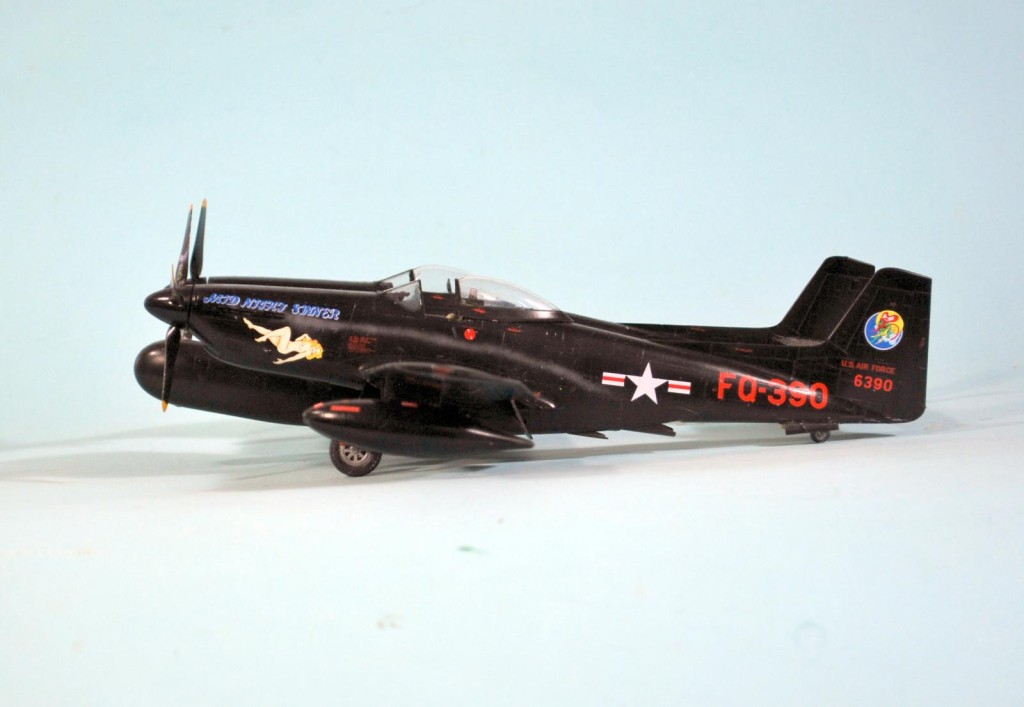
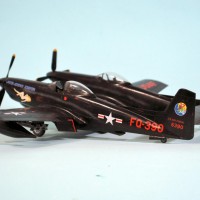
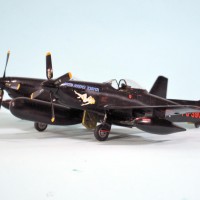
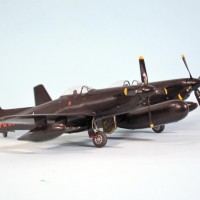
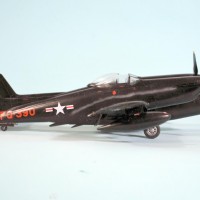
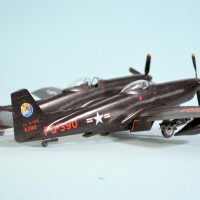
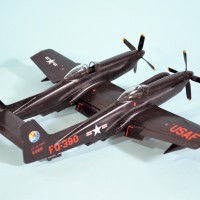
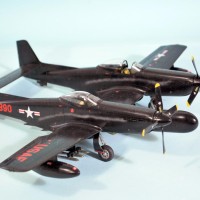
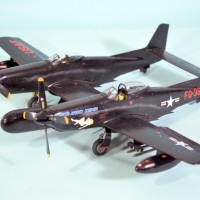
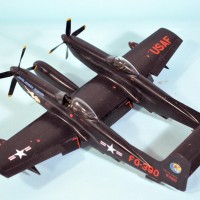
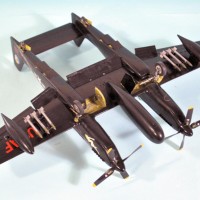
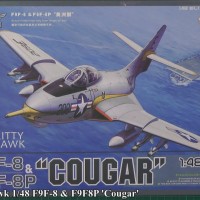
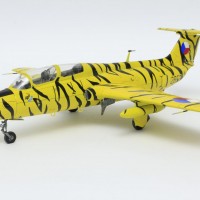
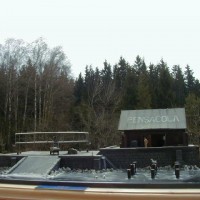
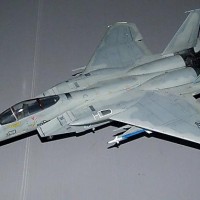
Lovely outcome with what sounds like a sort of fiddly kit. An unusual subject to be sure
This may be the first of these kits to make it to Headlines but I’m sure it won’t be the last, Modelsvit look to have a hit on their hands.
Amazing build and ditto article, Tom @tcinla
Great to see it on MM as well.
Beautiful build!
An amazing build of an excellent but demanding kit, Tom!
A meticulously written historical part.
Once again, well done!
You did a nice job on this one. Fast too!
Love the history lesson Tom! That's a good looking build, with some outstanding construction notes! ?
Build and story up to your usual standard!
Lots of great information and a good looking build. I am not big P-51 fan, but I do love the Twin look. Your American Zwilling really turned out nice Tom, @tcinla .
Great work and story Tom. Looks like Modelsvit did it right.
Thank you for the history and the excellent build Tom...I have one on order now.
Nicely done!
Tom, @tcinla
This is a great looking plane, and I thoroughly enjoyed reading your article. I definitely pressed the "like" button. You mentioned the decal sheet with the correct buzz numbers for the first kill F-82, but I don't see the number for it. Would you be so kind as to include it if possible ? I have one of these Modelsvit kits, and I would like to build it up as a part of our Korean War group. Your building tips will definitely be helpful.
Thanks in advance.
@lgardner - Hudson's airplane is FG-383. Only use the buzz number and the serial number from the PrintScale sheet - which makes Hudner's marking pretty expensive since there's nothing else on that sheet that isn't oversize and wrong.
Thanks Tom ! @tcinla
Do you know if there was anything else visible on this particular aircraft, such as unit markings or a name ? Or would it be possible to just add the buzz and serial numbers ?
@lgardner - it had the 68th FAWS insignia on the vertical fin - the decal in the kit is better than the too-big decal on the PrintScale sheet.
Thanks Tom. @tcinla I just might be able to cobble together a set of markings now. 🙂
Although the kit supplied decals also look very nice.
Fantastic model! Liked. I'd seen the sprues from the Modelcraft kit, and looked like there was more flash than kit styrene. This kit looks miles ahead. You mentioned that it was impossible to do the 5 rocket tree, was that because of the landing gear clearance or just the sub assembly of the tree? Great looking model.
Any chance modelsvit will release a P-82B (merlin powered) version?
@eydugstr - the rockets don't fit because you cannot slip the two lower ones into the position between the upper three - it's the size of the plastic.
No chance they would do a P-82B, that involves changing the molds. Perhaps someone in the aftermarket will do a different cowling. They are going to release the F-82E/H, probably later this year.
Tom you made quick work of that kit. I hope I can keep the focus and have to time to do the same. Nice Work!